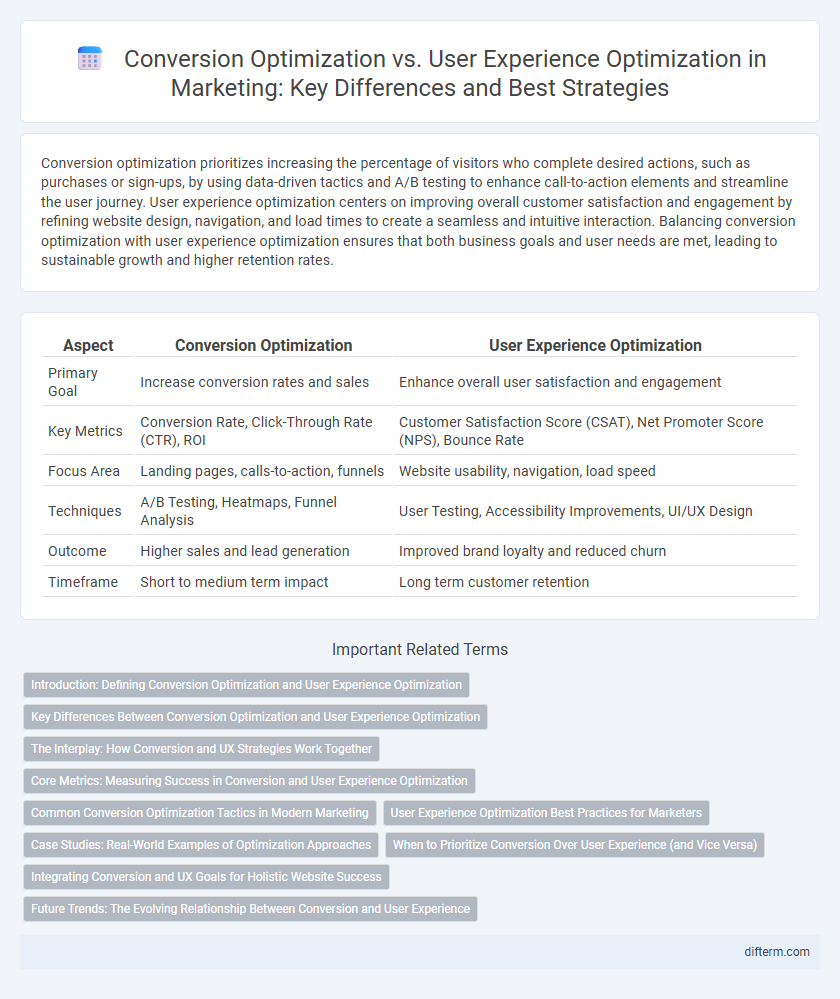Conversion optimization prioritizes increasing the percentage of visitors who complete desired actions, such as purchases or sign-ups, by using data-driven tactics and A/B testing to enhance call-to-action elements and streamline the user journey. User experience optimization centers on improving overall customer satisfaction and engagement by refining website design, navigation, and load times to create a seamless and intuitive interaction. Balancing conversion optimization with user experience optimization ensures that both business goals and user needs are met, leading to sustainable growth and higher retention rates.
Table of Comparison
| Aspect | Conversion Optimization | User Experience Optimization |
|---|---|---|
| Primary Goal | Increase conversion rates and sales | Enhance overall user satisfaction and engagement |
| Key Metrics | Conversion Rate, Click-Through Rate (CTR), ROI | Customer Satisfaction Score (CSAT), Net Promoter Score (NPS), Bounce Rate |
| Focus Area | Landing pages, calls-to-action, funnels | Website usability, navigation, load speed |
| Techniques | A/B Testing, Heatmaps, Funnel Analysis | User Testing, Accessibility Improvements, UI/UX Design |
| Outcome | Higher sales and lead generation | Improved brand loyalty and reduced churn |
| Timeframe | Short to medium term impact | Long term customer retention |
Introduction: Defining Conversion Optimization and User Experience Optimization
Conversion optimization focuses on increasing the percentage of visitors who complete desired actions such as purchases or sign-ups by analyzing user behavior and implementing targeted strategies. User experience optimization aims to enhance overall satisfaction by improving website usability, accessibility, and engagement. Both approaches are crucial for driving business growth but emphasize different aspects of the customer journey.
Key Differences Between Conversion Optimization and User Experience Optimization
Conversion optimization targets increasing specific actions such as purchases, sign-ups, or clicks by analyzing user behavior and adjusting elements like call-to-action buttons and landing pages. User experience optimization emphasizes enhancing overall satisfaction, usability, and accessibility through intuitive design, faster load times, and clear navigation. While conversion optimization drives measurable business outcomes with targeted tactics, user experience optimization builds long-term engagement by creating seamless and pleasant interactions across the customer journey.
The Interplay: How Conversion and UX Strategies Work Together
Conversion optimization and user experience optimization work synergistically to enhance website effectiveness by aligning user needs with business goals. Focusing on seamless navigation, intuitive design, and persuasive calls-to-action increases engagement while reducing bounce rates, ultimately driving higher conversion rates. Balancing data-driven CRO techniques with empathetic UX insights ensures that users enjoy a meaningful interaction that encourages action without frustration.
Core Metrics: Measuring Success in Conversion and User Experience Optimization
Conversion optimization centers on metrics such as conversion rate, average order value, and customer acquisition cost to drive revenue growth. User experience optimization emphasizes engagement metrics like session duration, bounce rate, and Net Promoter Score (NPS) to enhance satisfaction and loyalty. Balancing these core metrics ensures a strategic approach that maximizes both sales performance and user retention.
Common Conversion Optimization Tactics in Modern Marketing
Common conversion optimization tactics in modern marketing focus on A/B testing landing pages, improving call-to-action clarity, and personalizing content based on user behavior data. Techniques like heatmaps and session recordings help identify user interaction patterns to reduce friction points and increase conversion rates. Leveraging these data-driven insights ensures alignment between user experience optimization and achieving higher engagement and sales.
User Experience Optimization Best Practices for Marketers
User experience optimization focuses on enhancing website design, navigation, and content relevance to boost user satisfaction and engagement, which in turn leads to higher conversion rates. Key best practices include responsive design, fast loading times, intuitive interface layouts, and personalized content tailored to user behavior. Marketers should leverage A/B testing, user feedback, and data analytics to continuously refine UX elements, ensuring frictionless interactions and improved customer journeys.
Case Studies: Real-World Examples of Optimization Approaches
Case studies reveal that conversion optimization strategies often increase immediate sales by 20-40% through A/B testing and targeted CTAs, while user experience optimization enhances long-term customer loyalty and engagement metrics by improving site navigation and reducing bounce rates by up to 30%. Companies like Amazon prioritize seamless UX to boost lifetime value, whereas brands such as HubSpot leverage conversion optimization for rapid lead generation. Integrating both approaches based on real-world data leads to balanced outcomes maximizing revenue and customer satisfaction.
When to Prioritize Conversion Over User Experience (and Vice Versa)
Prioritize conversion optimization when immediate sales, lead generation, or key performance indicators (KPIs) must be met, particularly during high-stakes campaigns or product launches. Focus on user experience optimization when building long-term brand loyalty, reducing churn, or enhancing customer satisfaction to create sustainable growth. Balancing data-driven insights and user feedback ensures the optimal timing to switch emphasis between conversion rates and user experience.
Integrating Conversion and UX Goals for Holistic Website Success
Integrating conversion optimization and user experience (UX) goals drives holistic website success by aligning metrics such as bounce rates, session duration, and conversion funnels to create seamless user journeys. Employing A/B testing alongside heatmaps and user feedback helps identify friction points while maintaining intuitive navigation and fast load times, boosting both engagement and conversion rates. Balancing persuasive design elements with unobtrusive UX features ensures optimized landing pages that satisfy both immediate sales targets and long-term brand loyalty.
Future Trends: The Evolving Relationship Between Conversion and User Experience
Conversion optimization and user experience optimization are increasingly intertwined as AI-powered analytics and personalized content reshape digital marketing strategies. Emerging technologies such as machine learning enable real-time adaptation of user interfaces to maximize both engagement and conversion rates. The future of marketing relies on harmonizing these approaches to create seamless, data-driven experiences that drive sustained business growth.
Conversion optimization vs user experience optimization Infographic

 difterm.com
difterm.com